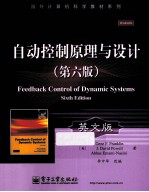

自动控制原理与设计 第6版 英文版PDF电子书下载
- 电子书积分:17 积分如何计算积分?
- 作 者:(美)富兰克林著
- 出 版 社:北京:电子工业出版社
- 出版年份:2013
- ISBN:9787121191022
- 页数:590 页
Chapter 1 An Overview and Brief History of Feedback Control 1
A Perspective on Feedback Control 1
Chapter Overview 2
1.1 A Simple Feedback System 3
1.2 A First Analysis of Feedback 6
1.3 A Brief History 9
1.4 An Overview of the Book 14
Problems 16
Chapter 2 Dynamic Response 19
A Perspective on System Response 19
Chapter Overview 20
2.1 Review of Laplace Transforms 20
2.1.1 Response by Convolufion 20
2.1.2 Transfer Functions and Frequency Response 25
2.1.3 The L_Laplace Transform 32
2.1.4 Properties of Laplace Transforms 34
2.1.5 Inverse Laplace Transform by Partial-Fraction Expansion 36
2.1.6 The Final Value Theorem 38
2.1.7 Using Laplace Transforms to Solve Problems 39
2.1.8 Poles and Zeros 41
2.1.9 Linear System Analysis Using MATLAB 42
2.2 System Modeling Diagrams 48
2.2.1 The Block Diagram 48
2.2.2 Block Diagram Reduction Using MATLAB 53
2.3 Effect of Pole Locations 54
2.4 Time-Domain Specifications 62
2.4.1 Rise Time 62
2.4.2 Overshoot and Peak Time 63
2.4.3 Settling Time 64
2.5 Effects of Zeros and Additional Poles 66
2.6 Stability 76
2.6.1 Bounded Input-Bounded Output Stability 76
2.6.2 Stability of LTI Systems 77
2.6.3 Routh's Stability Criterion 78
2.7 Historical Perspective 87
Problems 89
Chapter 3 A First Analysis of Feedback 108
A Perspective on the Analysis of Feedback 108
Chapter Overview 109
3.1 The Basic Equations of Control 109
3.1.1 Stability 111
3.1.2 Tracking 112
3.1.3 Regulation 112
3.1.4 Sensitivity 113
3.2 Control of Steady-State Error to Polynomial Inputs:System Type 116
3.2.1 System Type for Tracking 117
3.2.2 System Type for Regulation and Disturbance Rejection 121
3.3 The Three-Term Controller:PID Control 124
3.3.1 Proportional Control(P) 125
3.3.2 Proportional Plus Integral Control(PI) 125
3.3.3 PID Control 126
3.3.4 Ziegler-Nichols Tuning of the PID Controller 130
3.4 Introduction to Digital Control 136
3.5 Historical Perspective 141
Problems 145
Chapter 4 The Root-Locus Design Method 158
A Perspective on the Root-Locus Design Method 158
Chapter Overview 159
4.1 Root Locus of a Basic Feedback System 159
4.2 Guidelines for Determining a Root Locus 164
4.2.1 Rules for Plotting a Positive(180°)Root Locus 166
4.2.2 Summary of the Rules for Determining a Root Locus 171
4.2.3 Selecting the Parameter Value 172
4.3 Selected Illustrative Root Loci 174
4.4 Design Using Dynamic Compensation 186
4.4.1 Design Using Lead Compensation 187
4.4.2 Design Using Lag Compensation 192
4.4.3 Design Using Notch Compensation 193
4.4.4 Analog and Digital Implementations 195
4.5 A Design Example Using the Root Locus 198
4.6 Extensions of the Root-Locus Method 204
4.6.1 Rules for Plotting a Negative(0°)Root Locus 205
4.7 Historical Perspective 208
Problems 212
Chapter 5 The Frequency-Response Design Method 228
A Perspective on the Frequency-Response Design Method 228
Chapter Overview 229
5.1 Frequency Response 229
5.1.1 Bode Plot Techniques 236
5.1.2 Steady-State Errors 247
5.2 Neutral Stability 249
5.3 The Nyquist Stability Criterion 251
5.3.1 The Argument Principle 252
5.3.2 Application to Control Design 253
5.4 Stability Margins 266
5.5 Bode's Gain-Phase Relationship 273
5.6 Closed-Loop Frequency Response 278
5.7 Compensation 279
5.7.1 PD Compensation 280
5.7.2 Lead Compensation 280
5.7.3 PI Compensation 292
5.7.4 Lag Compensation 292
5.7.5 PID Compensation 297
5.7.6 Design Considerations 303
5.8 Historical Perspective 305
Problems 308
Chapter 6 State-Space Design 328
A Perspective on State-Space Design 328
Chapter Overview 328
6.1 Advantages of State-Space 329
6.2 System Description in State-Space 331
6.3 Block Diagrams and State-Space 338
6.3.1 Time and Amplitude Scaling in State-Space 340
6.4 Analysis of the State Equations 341
6.4.1 Block Diagrams and Canonical Forms 341
6.4.2 Dynamic Response from the State Equations 352
6.5 Control-Law Design for Full-State Feedback 358
6.5.1 Finding the Control Law 359
6.5.2 Introducing the Reference Input with Full-State Feedback 367
6.6 Selection of Pole Locations for Good Design 371
6.6.1 Dominant Second-Order Poles 372
6.6.2 Symmetric Root Locus(SRL) 373
6.6.3 Comments on the Methods 382
6.7 Estimator Design 382
6.7.1 Full-Order Estimators 382
6.7.2 Reduced-Order Estimators 388
6.7.3 Estimator Pole Selection 392
6.8 Compensator Design:Combined Control Law and Estimator 394
6.9 Introduction of the Reference Input with the Estimator 407
6.9.1 A General Structure for the Reference Input 408
6.9.2 Selecting the Gain 418
6.10 Integral Control and Robust Tracking 418
6.10.1 Integral Control 419
6.11 Historical Perspective 421
Problems 424
Chapter 7 Nonlinear Systems 444
Perspective on Nonlinear Systems 444
Chapter Overview 445
7.1 Introduction and Motivation:Why Study Nonlinear Systems? 445
7.2 Analysis by Linearization 447
7.2.1 Linearization by Small-Signal Analysis 448
7.2.2 Linearizafion by Nonlinear Feedback 453
7.2.3 Linearization by Inverse Nonlinearity 453
7.3 Equivalent Gain Analysis Using the Root Locus 454
7.3.1 Integrator Antiwindup 460
7.4 Equivalent Gain Analysis Using Frequency Response:Describing Functions 464
7.4.1 Stability Analysis Using Describing Functions 470
7.5 Historical Perspective 474
Problems 476
Chapter 8 Control System Design:Principles and Case Studies 483
A Perspective on Design Principles 483
Chapter Overview 484
8.1 An Outline of Control Systems Design 485
8.2 Design of a Satellite's Attitude Control 490
8.3 Lateral and Longitudinal Control of a Boeing 747 507
8.3.1 Yaw Damper 512
8.3.2 Altitude-Hold Autopilot 519
8.4 Control of the Fuel-Air Ratio in an Automotive Engine 525
8.5 Control of the Read/Write Head Assembly of a Hard Disk 532
8.6 Control of RTP Systems in Semiconductor Wafer Manufacturing 540
8.7 Chemotaxis or How E.Coli Swims Away from Trouble 554
8.8 Historical Perspective 562
Problems 566
Appendix Solutions to the Review Questions 579
- 《卓有成效的管理者 中英文双语版》(美)彼得·德鲁克许是祥译;那国毅审校 2019
- 《第一性原理方法及应用》李青坤著 2019
- 《计算机组成原理解题参考 第7版》张基温 2017
- 《高含硫气藏开发腐蚀控制技术与实践》唐永帆,张强 2018
- 《高等院校保险学专业系列教材 保险学原理与实务》林佳依责任编辑;(中国)牟晓伟,李彤宇 2019
- 《AutoCAD 2018自学视频教程 标准版 中文版》CAD/CAM/CAE技术联盟 2019
- 《刑法归责原理的规范化展开》陈璇著 2019
- 《教师教育系列教材 心理学原理与应用 第2版 视频版》郑红,倪嘉波,刘亨荣编;陈冬梅责编 2020
- 《跟孩子一起看图学英文》张紫颖著 2019
- 《单片机原理及应用》庄友谊 2020
- 《电子测量与仪器》人力资源和社会保障部教材办公室组织编写 2009
- 《少儿电子琴入门教程 双色图解版》灌木文化 2019
- 《指向核心素养 北京十一学校名师教学设计 英语 七年级 上 配人教版》周志英总主编 2019
- 《北京生态环境保护》《北京环境保护丛书》编委会编著 2018
- 《指向核心素养 北京十一学校名师教学设计 英语 九年级 上 配人教版》周志英总主编 2019
- 《通信电子电路原理及仿真设计》叶建芳 2019
- 《高等院校旅游专业系列教材 旅游企业岗位培训系列教材 新编北京导游英语》杨昆,鄢莉,谭明华 2019
- 《电子应用技术项目教程 第3版》王彰云 2019
- 《中国十大出版家》王震,贺越明著 1991
- 《近代民营出版机构的英语函授教育 以“商务、中华、开明”函授学校为个案 1915年-1946年版》丁伟 2017
